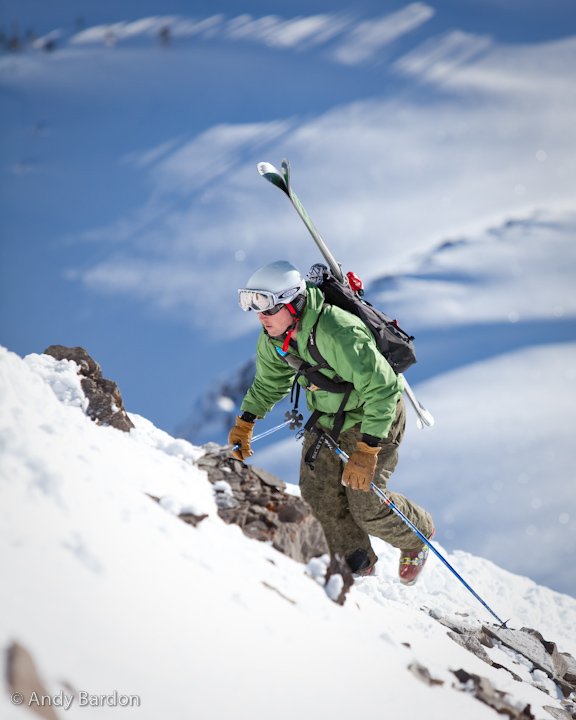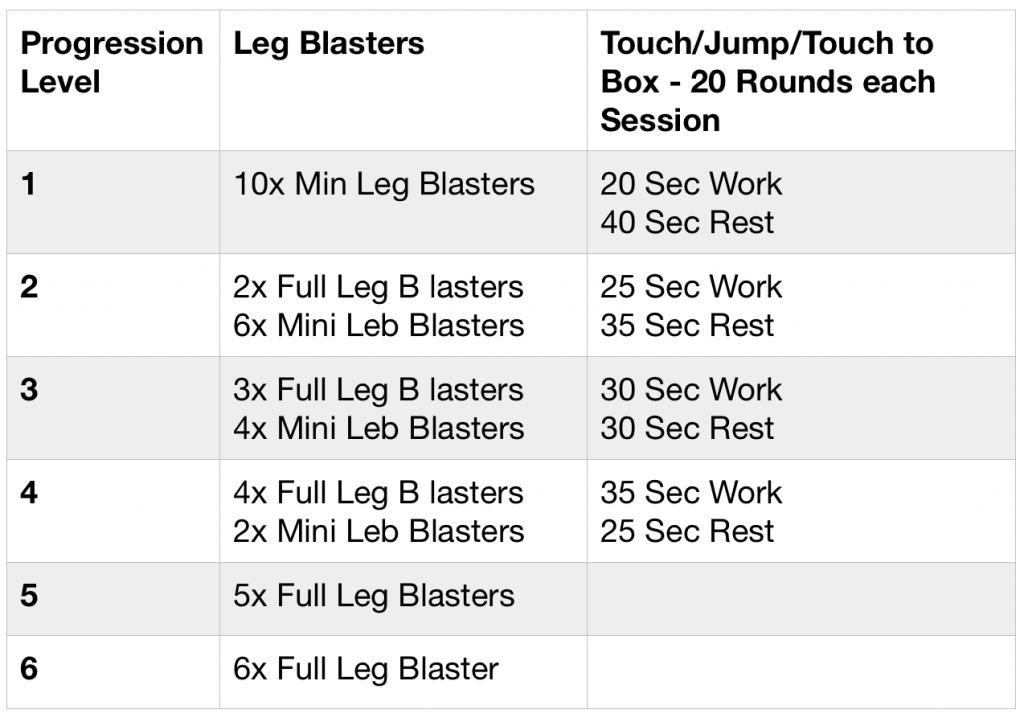
By Rob Shaul
MTI’s Fall Backcountry Ski Training Cycle is one of the few coached training cycles we open up to the public for training. It’s still a “Lab Rat” cycle where we test programming, however, the extra number of athletes provides more data points for our testing and overall evaluation.
Our process is direct and I do it every year. We take a look at the previous year’s programming, its results, make changes to the current year based on these results and other insights, design the programming and deploy it and then study the results.
The “results” we evaluate are not gym-based. Rather, we give the “lab rats” 4-6 weeks to actually ski, then ask for feedback on how well the were prepared.
If the results are good, in the January/February time frame, we’ll update the website with programming improvements based on our fall cycle.
Background
Our Fall Dryland Cycle is designed to prepare athletes for lift-assisted downhill, side country, and backcountry, skiing. These activities have 3 specific fitness demands:
(1) Eccentric Leg Strength and Strength Endurance – During downhill or alpine skiing, gravity “bounces” the skier down the hill, and eccentric leg strength is demanded to absorb every drop and prevent gravity from driving the skier into the ground.
(2) Leg Lactate Tolerance – This is an MTI-specific idea and term I developed to describe the quad burn skiers feel in the middle to the end of a long ski run, especially through bumps, variable terrain, or powder. The concept does not include the obvious muscle fatigue, but also the anaerobic cardio hit.
(3) Uphill hiking/skinning endurance and stamina – both side country and backcountry skiing have significant uphill components – boot packing mostly for side country and skinning mostly for backcountry. Preparing athlete’s legs and lungs for this uphill movement is a key focus of our dryland ski training cycles.
These are four days/week, 7-week cycles with the individual training sessions traditionally designed to last 60 minutes. This year, however, we’ve cut the session time to 40-45 minutes as one of the elements we’re testing.
Below is the basic weekly schedule for this year’s cycle:
- Monday: Eccentric Leg Strength (leg blasters), Uphill Endurance (step ups)
- Tuesday: Chassis Integrity + Upper Body Strength Circuit, Leg Lactate Tolerance (touch/jump/touch to a box)
- Wednesday: Leg Lactate Tolerance (sled push intervals), Uphill Endurance (step ups)
- Thursday: Chassis Integrity + Upper Body Strength Circuit, Leg Lactate Tolerance (touch/jump/touch to a box)
- Friday – Sunday: Rest or light activity
Changes to the 2019 Cycle
1) Halved training devoted to eccentric leg strength – and limited it to an aggressive unloaded Leg Blaster progression.
In 2018 we trained eccentric leg strength via unloaded and loaded leg blaster progression, two times per week. This year, we’ve halved that, to one time per week, and dropped the loading. We feel the touch/jump/touch to box intervals train eccentric leg strength as well and are interested to see if we can continue with an aggressive leg blaster progression by training these just once per week. Also – last year a few of my veteran lab rats completed the leg blaster progression loaded – wearing a weight vest – but not so this year. Everyone is completing the progression unloaded. We’re not sure the loading last year added enough to the strength gains to outweigh the impact on the joints.
2) Cut the session length to 45 minutes.
We’re currently running an unrelated remote-lab rat mini-study to test the effectiveness of reduced volume on fitness gains. We wanted to test that idea with this dryland ski cycle, also. In the past, these sessions have extended to 60 minutes. This year, we are finishing in 35-45 minutes. How? We’ve simplified the exercise menu significantly and essentially dropped the warm ups. On Mondays, athletes roll right into their leg blasters. On Tuesdays and Thursdays, the session begins with chassis integrity (core) and upper body strength circuit (Scotty Bobs for the first 3 weeks), and on Wednesdays, we go right to the sled pushes. Many of our warm ups included squats, push ups, lunges, sandbag work, and short sprints anyway, so we were interested in skipping them altogether to simplify/shorten the session, and decrease the overall volume.
In terms of program design, we’ve learned over the years that improvements generally come from cutting stuff, rather than adding stuff. Most programs begin “bloated” with elements which after deployment prove to have limited value. The hard part of programming is not cutting these elements, but avoiding the natural temptation to replace them with some other element. I’ve learned it takes experience and confidence to cut the unnecessary stuff, and instead of replacing it with more extras, find ways to increase the time spent on the programming that we know works and transfers to directly to the mission, event or sport.
3) Dropped the multi-modal endurance work, and went back to loaded straight step ups.
With the decrease in session length comes a need to be more efficient. Last year our endurance work focused on extending lengths of a step up/shuttle/lunge circuit. But, with each exercise change, comes a break in training By simplifying, and going straight to step ups, we can still hammer uphill endurance, and be as efficient as possible.
4) Added 20 minutes of sled push intervals.
Two goals with these: (1) See if the leg lactate tolerance work from sled push intervals transfers to skiing, and; (2) Develop a sled push programming progression and theory. Concerning (1), it could very well be there is no transfer, and the suffering myself and the other lab rats are doing every Wednesday is just making us better at pushing the sled…. we won’t know until we start skiing. Part (2), however, is a very interesting programming problem. Often I’ll get asked about using sled pushes as a conditioning tool, and how to do so. This is difficult to answer, because sled pushing difficulty depends on the sled’s friction with the sliding surface. This in part depends upon the sled material, sliding surface material, and weight of the sled – all of which, unlike a barbell and plates, are not standardized gym to gym.
So I’m working on developing a timed, work to rest, interval protocol. To be efficient, we’ll set up a “track” on our small turf area about 30-feet in length, and run multiple sleds concurrently, following each other around the track (see video). To change the work to rest interval, I’ll simply add another sled, or pull one from the rotation. Finally, I’m actually using our big plyo boxes for sleds – top maintain consistency. We only have two metal sleds, but I have 4 plyo boxes. We’re finding that with 3 athletes per sled, the work to rest ratio is about 20:40 (in seconds). Dropping to two athletes per sled pushed the work to rest ratio to 20:30ish – which is surprisingly difficult.
20 minutes of this isn’t fun …. as we’re finding out. So far, with my most fit lab rat group, we’ve only attempted 10 minutes of the 2 people per sled progression level, which will make your heart want to explode out of your chest …
What’s Stayed the Same
1) Touch/Jump/Touch To Box – Inside Hand Touch -Straight 20 minutes of Intervals
This worked very well last year, to great effect – almost to the point where we’re starting to wonder if we couldn’t design a very effective dryland ski cycle with just Touch/Jump/Touch to Box Intervals!
The first video below shows the 2018 (last year) lab rats completing 20-second intervals to a 17″ bench, with a 40-second rest between intervals. We’re doing 20 rounds of this in a row (20 minutes total), with an aggressive progression which both increases the work time and decreases the rest time.
3) Upper Body Hypertrophy & Chassis Integrity
The cycle’s non-leg programming is focused on building upper body strength/mass, and functional core strength. We’re doing this with 15- to 20-minute circuits at the beginning of the Tues/Thurs sessions which group two chassis integrity exercises with 1-2 upper body exercises. The upper bodywork is given a set/rep scheme of 8+ reps/set to build mass and the chassis integrity exercises always include the sandbag get up. Goal here is to not only train these other fitness attributes but also double as a fairly intense warm up to prepare the lab rats for the touch/jump/intervals which follow.
Lessons Learned So Far
We conclude the 2nd week of this 7-week cycle last week and the cycle is flowing along well. My progression for the leg blasters and the touch/jump/touch intervals is more aggressive than last year, but, the overall volume is less with the shorter training sessions … so perhaps this decrease in volume is allowing the lab rats to accommodate to the stress more quickly. See the chart below for the Leg Blaster and Touch/Jump/Touch to Box Progressions:

Questions, Comments, Feedback? Email coach@mtntactical.com
Learn More MTI’s Backcountry Ski Pre-Season Training Plan
STAY UPDATED
Sign-up for our BETA newsletter. Training tips, research updates, videos and articles - and we’ll never sell your info.
